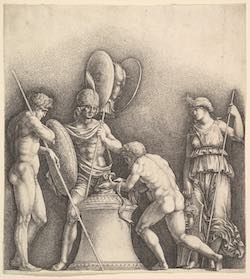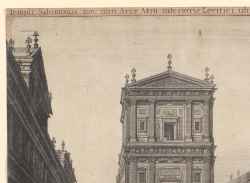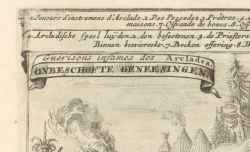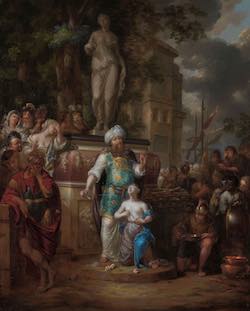Topic: 2. Sacrifice and religion: Comparisons, Antiquarians, Anthropology (16th-18th Century)
Religious sacrifices across various cultures and contexts sparked widespread interest in Early Modern Europe. As Christianity expanded into regions inhabited by "infidels" and "pagans", Europeans encountered a diverse array of sacrificial customs, ranging from the Sati rituals in India to the Aztec sacrifices in the Americas. This cross-cultural exposure captivated a wide audience, including theologians, philosophers, political thinkers, antiquarians, orientalists, missionaries, poets, artists, and even the general public. These encounters broadened the European understanding of sacrifice and led to a critical reassessment of classical and biblical sacrificial rites. This section includes:
- Sources: A selection of early modern printed materials, which include descriptions of the Americas, Asia, and Africa, alongside antiquarian and philological studies on religious sacrifice in classical antiquity and beyond. It also presents early modern works of ethnological observations and the first attempts to compare different sacrificial practices in various traditions and contexts, laying the groundwork for disciplines like the history of religions and anthropology.
- Iconographic Representations: A rich collection of images from the 16th to 18th centuries, illustrating a range of sacrificial rituals and practices as seen in different cultural and geographical contexts.
- Related Bibliography: An extensive bibliography spanning scholarly works from the 19th to 21st centuries, providing contemporary analyses and interpretations of these early studies and observations.
Leviathan
Oxford : Oxford University Press, Clarendon Edition of the Works of Thomas Hobbes, 2012-2014.
Kings and Councillors: An Essay in the Comparative Anatomy of Human Society
Chicago: University of Chicago Press, 1970.
0. General bibliography (19th-21th Century) 2. Sacrifice and religion: Comparisons, Antiquarians, Anthropology (16th-18th Century)
Early Anthropologies in the Sixteenth and Seventeenth Centuries
Philadelphia: University of Pennsylvania Press, 1964.
Bartholomeo Georgius
in: Christian-Muslim Relations: A Bibliographical History. vol. 7: Central and Eastern Europe, Asia, Africa and South America (1500–1600), pp. 321–30
Leiden: Brill, 2015.
Das sogenannte Feueropfer
in: Hebraeische Wortforschung. Festschrift zum 80. Geburtstag von W. Baumgartner, pp. 114-134
Leiden: Brill, 1967.
The ritualistic murder of a Christian child by a group of Jewish men; the child standing at centre, surrounded by five figures who are restraining, cutting him and gathering his blood; in an ornament frame with Gothic Laubwerk along upper edge; illustration to Ubertino Pusculino, 'Duo libri Symonidos de Judaeorum perfidia', Augsburg: Johan Ottmar, 1511. (1511)
from: Ubertino Pusculino, 'Duo libri Symonidos de Judaeorum perfidia', Augsburg: Johan Ottmar, 1511
Bristih Museum
Pomp and circumstance: royal symbolism and the ʿId al-Kabir sacrifice in Morocc
in: Arab Studies Journal, v. 19 (2011), issue 1: pp.66-93.
Four Classical Figures (Pagan Sacrifice) (1638)
Metropolitan Museum, New York
Burnt offerings in the Temple of Jerusalem from within the Court of the Levites (1660)
from: plate from the 'Restoration' Bible 2 vols., published by John Ogilby, Cambridge, 1660
National Gallery of Victoria, Melbourne
Interesting historical events, relative to the provinces of Bengal, and the empire of Indostan
London: Becket & De Hondt, 1765-1771.
In the left foreground a camel is being slaughtered. Religion in Japan. Shown are all kinds of large and small statues of gods. With legend in Dutch and French. (1682)
from: Vries, Simon de. Curieuse aenmerckingen der bysonderste Oost en West-Indische verwonderens-waerdige dingen, deel 3, p. 109. Utrecht: J. Ribbius, 1682
Rijksmuseum, Amsterdam
Japanese mendicants, lepers, muck-eaters, acts of self-immolation, the bathing of “Brahmins and fakirs,” Mexican human sacrifice and deities, and a Turkish dervish. (1682)
from: Simon de Vries (ca. 1580–1629), Curieuse Aenmerckingen der byzondereste Oost en West Indische… dingen (Curious Remarks on the most exceptional East and West Indian… matters), vol. 3 (Utrecht: Johannes Ribbius, 1682)
Rijksmuseum, Amsterdam
Landscape with aspects about sin and penance. On the right of the scene a child is being slaughtered. (1682)
from: Vries, Simon de. Curieuse aenmerckingen der bysonderste Oost en West-Indische verwonderens-waerdige dingen, deel 3, p. 6. Utrecht: J. Ribbius, 1682
Rijksmuseum, Amsterdam
the healers making an offering to an idol asking if it can cure the sick person. As atonement, a number of goats are slaughtered. In the process, the tent of the sick man is incensed. In the background is a thanksgiving feast at an idol. On the right image, a man (according to the text a Jesuit) is being shaved by a toll master in front of some Dutchmen. (1682)
from: Vries, Simon de. Curieuse aenmerckingen der bysonderste Oost en West-Indische verwonderens-waerdige dingen, deel 4, p. 664 en deel 3, p. 596. Utrecht: J. Ribbius, 1682
Rijksmuseum, Amsterdam
Sacrifice of Iphigenia [1690 - 1700]
Rijksmuseum, Amsterdam
Horse Sacrifice in Antiquity
in: Yale Classical Studies, v. 1 (1928), issue : pp.181-192.








